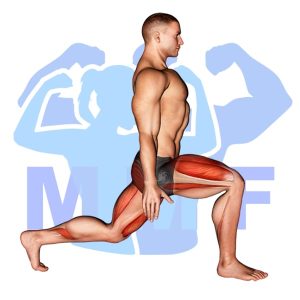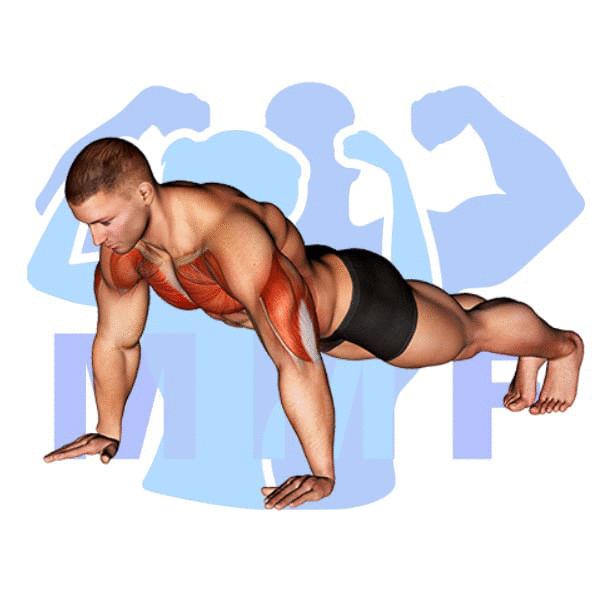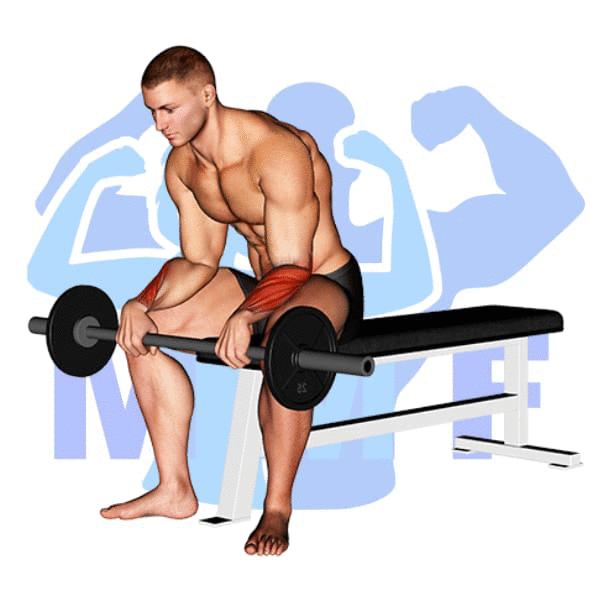Do you ever feel like you’re stuck in a fitness rut, doing the same old exercises day in and day out? Well, you’re not alone! Many people struggle to find new and exciting exercises to add to their workout routine. One exercise that often gets overlooked is the walking lunge. Don’t worry, it’s not your fault. The walking lunge can be intimidating, and many people don’t know the proper form. But fear not! In this post, we will break down the walking lunge, and provide you with step-by-step instructions to help you perfect your form and add this effective exercise to your daily routine.
Walking Lunge Summary
- Primary Muscles: Gluteus Maximus
- Secondary Muscles: Adductor Magnus, Quadriceps, and Soleus
- Equipment: Body Weight
- Mechanics Type: Compound
- Force: Push
- Utility: Auxiliary

Walking Lunge Instructions
- Start off by finding an area where you can lunge a long distance in a straight line.
- Next, step out approximately twice your normal walking stride length.
- Bend both knees so that the back knee nearly touches the ground but does not make contact.
- Then push off with your back leg with enough force to bring it up next to your front leg, with you standing up.
- Next, lunge out with your opposite leg and continue and turn around when you run out of space, then turn around and keep going, don’t stop and get it
Video Tutorial
Walking Lunge Muscles
Target (Agonist)
Synergists
- Adductor Magnus
- Quadriceps
- Soleus
Dynamic Stabilizers
Stabilizers
- None
Antagonist Stabilizers
- None

Benefits of Walking Lunge
The Walking Lunge is a great exercise for targeting the Gluteus Maximus. This muscle is the largest and most powerful in the body and is responsible for hip extension, abduction, and external rotation. By performing the Walking Lunge, you can effectively strengthen your glutes and help improve your overall balance and stability. Additionally, this exercise helps to engage other muscles such as the quads, hamstrings, and core muscles, making it a great overall lower body exercise.
Tips for Performing Walking Lunge
If you’re seeking to take the walking lunge to the next level, then you’re at the right place. Using these suggestions can enable you to take full advantage of this amazing workout. Concurrently with building your glutes muscles, increasing movability, and even a reduced possibility of injury can all be achieved with this exercise. Let’s begin and explore how these suggestions will help you.
- Keep your back straight: Make sure to keep your back straight while doing Walking Lunges. This will help prevent injuries and ensure proper form.
- Focus on balance: When you do Walking Lunges, focus on keeping your balance and staying in control of your movements. This will help you get the most out of each repetition and make sure you are getting a good workout.
- Increase your range of motion: As you get used to Walking Lunges, gradually increase the range of motion you use with each step. This will help you build strength and endurance in your legs and core muscles.
Benefits and Tips Video
Frequent Mistakes To Avoid
When conducting walking lunge, keeping away from common errors is key to getting the most out of the exercise and avoiding injury. Moreover, achieving optimal results from this exercise requires proper form, and making sure you don’t make any common mistakes can allow you to perform the exercise better and achieve your desired results. Don’t worry, though, it’s not at all difficult as it might appear. You can perform the exercise safely and effectively by avoiding the mistakes to prevent and by executing the correct steps. Thus, it is now your turn to maximize your results from this exercise and enjoy the benefits of a productive workout.
- Not keeping the torso upright: When performing a Walking Lunge, it is important to keep the torso upright to ensure that the movement is being performed correctly. If the torso is bent forward, it can cause strain on the lower back and hamstrings.
- Not driving through the heel: When performing a Walking Lunge, it is important to drive through the heel of the front foot in order to activate the glutes and hamstrings. Not doing so can put unnecessary stress on the knees, causing injury.
- Not lowering deep enough: When performing a Walking Lunge, it is important to lower the body deep enough so that the knee of the front leg is aligned with the ankle. Not doing so can reduce the effectiveness of the exercise and may cause poor form and increased risk of injury.
Find More Bodyweight Exercises Here
Variations and Complementary Exercises
Walking Lunges are a great exercise for strengthening your legs, butt, and core muscles. However, if you’re looking to switch up your routine or need a break from the walking lunge exercise, there are a few variations, complementary, and alternative exercises that you can do to get the same results.
Lunge

The Lunge exercise is a great complement or alternative to Walking Lunges. This exercise requires a person to stand tall with feet shoulder-width apart, and then take a large step forward with one leg while keeping the other leg stationary. The person then lowers their body by bending both legs until the back knee is close to the floor. The person then pushes off the front foot and returns to the starting position. This exercise strengthens the lower body muscles, including the glutes, quads, hamstrings, and calves. It also helps to improve balance and stability.
Rear Lunge

Rear Lunge is a great complementary or alternative exercise for Walking Lunge. It is a single-leg movement that targets the same muscle groups as Walking Lunge, but it also targets the glutes and hamstrings more specifically. To perform Rear Lunge, stand with feet hip-width apart and step back with one leg into a lunge position. Make sure to keep your chest up, abs engaged, and back straight. Lower your back knee to the floor and keep your front knee bent at a 90-degree angle. Hold for a few seconds, then return to the starting position. Rear Lunge is great for strengthening and toning the legs, improving balance and coordination, and increasing flexibility.
Barbell Rear Lunge

The Barbell Rear Lunge is a great complementary or alternative exercise to the Walking Lunge. This exercise focuses on building strength in the glutes and hamstrings, as well as targeting the stabilizing muscles of the hips and core. It requires a barbell loaded with weights and is performed by standing with your feet hip-width apart and the barbell resting on your back. Step back with one leg and lower your body until your front knee is bent at a 90-degree angle and your rear knee is just above the ground. Push through your front heel to return to the starting position and repeat with the other leg. This exercise is a great way to increase balance, strength, and stability in your lower body.
Check Out These Top Bodyweight Exercises
Barbell Reverse Lunge

The Barbell Reverse Lunge is a great complementary or alternative exercise to the Walking Lunge. It is an effective way to target the glutes, hamstrings, and quads, while also engaging the core muscles. Unlike the Walking Lunge, the Barbell Reverse Lunge requires you to step backward instead of forward, and you will be using a barbell for additional resistance. This exercise is also a great way to increase balance and stability, as you are required to maintain a good posture throughout the movement.
Barbell Walking Lunge

Barbell Walking Lunge is a great complementary exercise to the Walking Lunge. This exercise requires you to hold a barbell across your shoulders while performing the same lunge motion. This adds an additional challenge to the exercise, as it requires more balance and stability while performing the movement. It also increases the intensity of the exercise, as the extra weight forces your muscles to work harder. Furthermore, Barbell Walking Lunge allows you to target specific muscle groups more effectively than the traditional Walking Lunge. This makes it a great alternative for those who want to increase their strength and muscular endurance.
Dumbbell Lunge

Dumbbell Lunges are an effective alternative to Walking Lunges and can provide a complementary exercise for lower body strengthening. This exercise is completed by standing with your feet shoulder-width apart, holding a dumbbell in each hand. Step forward with one leg and lower your hips until your back knee is close to the floor. Push off your front foot and return to the starting position. This exercise increases strength and stability in the legs and glutes, as well as the core. Additionally, it increases the range of motion in the hips, which can be beneficial for athletes or those who are looking to improve their mobility.
Find More Glutes Exercises Here
Opposing Complementary Exercises
In order to maximize the benefits of the Walking Lunge, it is important to include exercises that target opposing muscle groups. This will help to ensure that the body remains in balance and help avoid any potential injuries. To complement this exercise, consider adding the following exercises to your workout routine:
Barbell Front Sumo Squat

The Barbell Front Sumo Squat is a great complement to the Walking Lunge. This exercise targets the quads, inner thighs, and glutes, while the Walking Lunge focuses on the hamstrings and glutes. This combination of exercises ensures that all the major muscles in the lower body are being worked, providing a well-rounded workout. The Barbell Front Sumo Squat also helps to develop core stability and strengthen the lower back. By doing both exercises together, you can increase overall strength, balance, and stability.
Barbell Full Squat

Barbell Full Squats and Walking Lunges are complementary exercises that work opposing muscle groups. The Barbell Full Squat is a compound exercise that works the quadriceps, hamstrings, glutes, and core muscles. It involves standing with your feet shoulder-width apart and holding a barbell across your upper back. You then lower your body as far as you can by pushing your hips back and bending your knees. Walking Lunges, on the other hand, work the same muscle groups, but target them in different ways. Instead of a static hold, Walking Lunges involve moving forward with each lunge, alternating legs with each step. This dynamic movement helps to target the muscles in different ways, helping to strengthen and tone them. Together, these two exercises provide a comprehensive workout for the lower body muscles and core.
Barbell High Bar Squat

The Barbell High Bar Squat is an excellent exercise to pair with the Walking Lunge, as it utilizes the opposing muscle group. The Barbell High Bar Squat works the quadriceps, glutes, and hamstrings, while the Walking Lunge targets the glutes, hamstrings, and calves. Together, these two exercises create a balanced lower body workout that is sure to help you build strength and improve mobility. The Barbell High Bar Squat focuses on pushing through your heels to lift the weight up, while the Walking Lunge requires you to drive your leg forward and back with control. Combining these two exercises will help build a strong foundation for any leg day routine.
Stronger Legs, Fitter You
Stronger legs not only boost your confidence, but they also help you move swiftly and easily throughout your daily activities. Incorporating walking lunges into your fitness routine can be a great way to target your leg muscles while also increasing your cardiovascular endurance. Plus, with a variety of modifications available, walking lunges can be customized to fit any fitness level or ability. Whether you’re a beginner or a seasoned fitness enthusiast, walking lunges can help you achieve a fitter, stronger self.
References: Wikipedia | ExRx.net | PubMed.gov | Comprehensive List of Glutes Bodyweight Exercises




